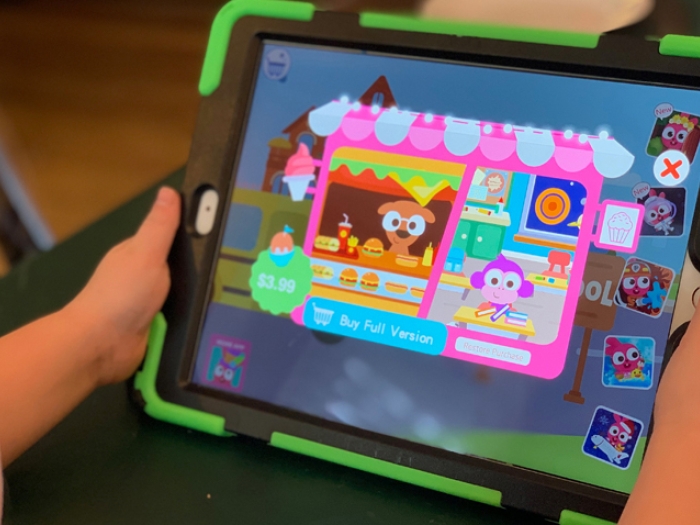Whether children are streaming videos, playing games or interacting with apps, habit-forming design plays a role. But its effect is largely unknown.
7:00 AM
Author |

Pediatricians, parents and early childhood providers see digital media encroaching on parts of child and family life that were previously secluded from media's influence.
MORE FROM THE LAB: Sign up for our weekly newsletter
Portable, instantly accessible devices are much easier to bring into our interpersonal spaces and downtime. And, perhaps more importantly, these devices use persuasive design.
In the 1990s, computer engineers started to observe what happened when computers interacted with users in humanlike ways. For example, when a dialogue box popped up and the text showed a sense of humor or seemed to be helping the user, users reported feeling that they "liked" the computer more and were more likely to trust it or work with it longer.
We now see persuasive design almost everywhere in technology: notes that say other people are browsing the same hotel as you, red alerts on your iPhone that beckon you, rewards for prolonged or repeated use of an app (e.g., Snapstreaks) or the ability to share what you're doing on social media.
Because it's clear these habit-forming design approaches really work, textbooks have outlined how to keep users maximally engaged with digital products.
Meanwhile, computer engineers have voiced concern about the ethics of manipulating user behavior. And, based on developmental science, scientists like me are concerned that children's developing brains are potentially more susceptible to persuasive design elements, including:
-
Visual and sound effects: In early childhood, executive control networks are emerging, but for the first few years, children are largely driven by alerting and orienting to important or novel stimuli. This is why screen media entrain attention well. Yet, because young children with their "bottom-up" processing are more likely to focus on flashy or salient features, they often miss the educational content of information presented on tablets and likely on apps. It's just so satisfying to pop all those bubbles, make Talking Tom wince over and over, or hear the clink of coins accumulating!
-
Rewards: Stickers, tokens, virtual toys, clothes and jewelry. These are highly reinforcing, which is why we use real sticker charts, happy faces, check marks and tokens to reinforce positive behaviors at home and in school throughout early childhood. I don't think I need to say anything more than that my 2 1/2-year-old son gleefully yelled, "I got a present!" in the middle of playing LEGO Juniors. It was instantly his favorite game.
-
Wish fulfillment: My lab members have been playing children's apps for the past few months. An amazing number have pretty teachers telling the user how smart they are, wild animals with hair children can cut and style, babies to raise and more activities kids can't always do IRL. In early childhood, we often use wish fulfillment as a way to help children handle frustration by appealing to their magical thinking (e.g., letting a child pretend he is the teacher or circus ringmaster to have control over everyone), but we just don't know what these types of virtual wish fulfillment experiences do for young children.
-
Parasocial relationships: While positive feedback from friends on social media is a huge motivator for adults, children receive analogous social reinforcement from familiar characters with whom they have developed parasocial relationships. Research shows that toddlers learn better from familiar characters such as Elmo and Dora, whom they trust and pay more attention to. When familiar characters can teach knowledge and positive behaviors, it's great. When familiar characters try to get young children to make in-app purchases (a common practice that my lab is studying), it's not.
-
Autoplay: Can autoplay please not be the default setting? Young children have more tantrums when they see the countdown to the next episode. They don't have the same impulse control and self-regulation that adults have, so pausing the incoming exciting episode is much harder for them.
-
Machine learning: When you search on Google, it remembers your past behavior and prioritizes what it thinks you might want to see. It's very handy. But on YouTube and other video streaming services, or with virtual assistants like Siri or Alexa, this means children will keep being provided an increasingly constrained set of options or information or will see only paid prioritization. Because of their immature mental flexibility, young children love the same thing over and over. But this means that technology won't necessarily give them answers that broaden their horizons. I also wonder whether children, like adult participants in several research studies, will start to feel like their devices "know" them, and how this will change child media use.
-
No meta-awareness about persuasive design: Philosophers have argued that persuasive computers are only ethical if their persuasive nudges are transparent, and we can critically evaluate our response to them. Quite simply, young brains can't do this.
-
Elbowing out the adult: Without this meta-awareness, young children need parents to teach them critical thinking skills around technology. But several new studies suggest that, compared with traditional toy play or book reading, tablet play doesn't create a space for the parent. More fast-paced, single-user games induce more time stuck on the screen and make it harder for children to look up at their parents or share the screen-viewing experience. We've observed the child creating a solitary space around the tablet, around which the parent contorts his or her body to be part of the experience. When the parent is a bystander rather than a participant, it is much harder to enjoy co-playing and learning.
I advocate for evidence-supported design that allows the child to be the producer, direct the play experience, figure out which problems to solve and then be empowered to put his or her attention elsewhere.Jenny Radesky, M.D.
Does persuasive design make parenting harder?
In my interviews with parents of young children, they report feeling a lot less control over mobile and interactive media. They tell stories of letting the device run out of batteries rather than enforcing time limits with children; worrying about "addiction" because the children prefer digital play to all other activities; not trusting what type of data tech companies might be collecting; or feeling the need to go "cold turkey to get their kids back." Because mobile devices have such a "hook," many parents say the solution needs to be in the device.
SEE ALSO: Making Screen Time More Meaningful
At the same time, they express ambivalence about children's interactive media use, because of the strong cultural belief that it will be important for future education and jobs and because it works so well to keep kids peaceful and quiet.
At the Common Sense Media kids and tech conference, we will have a conversation about new ideas for ethics of persuasive design for kids. When researchers started thinking of socially persuasive computers in the 1990s, there were several publications discussing design ethics surrounding influencing user behavior. I worry that ever since companies realized how amazingly effective persuasive design is at selling things, the ethics conversation has gotten muted and needs to be reopened.
This not only will solve child-centered ethical concerns, but also will have a better chance of making tech products the educational objects we want them to be. Thoughtful designers have highlighted the difference between open-ended, creative apps and apps based on drills, with adult-directed learning goals that position the child as consumer.
As part of this persuasive design discussion, I advocate for evidence-supported design that allows the child to be the producer, direct the play experience, figure out which problems to solve and then be empowered to put his or her attention elsewhere.

Explore a variety of health care news & stories by visiting the Health Lab home page for more articles.

Department of Communication at Michigan Medicine
Want top health & research news weekly? Sign up for Health Lab’s newsletters today!





